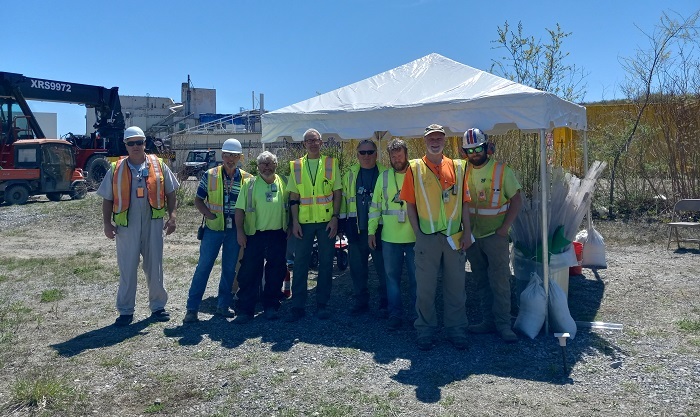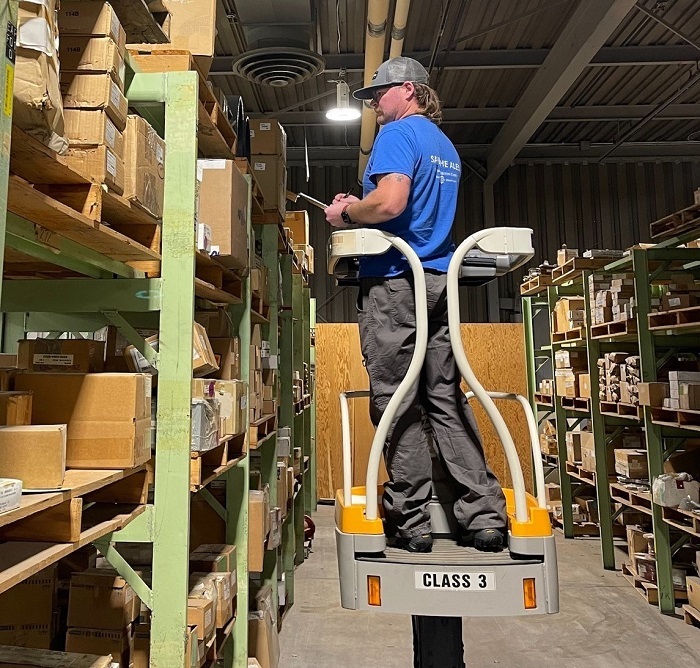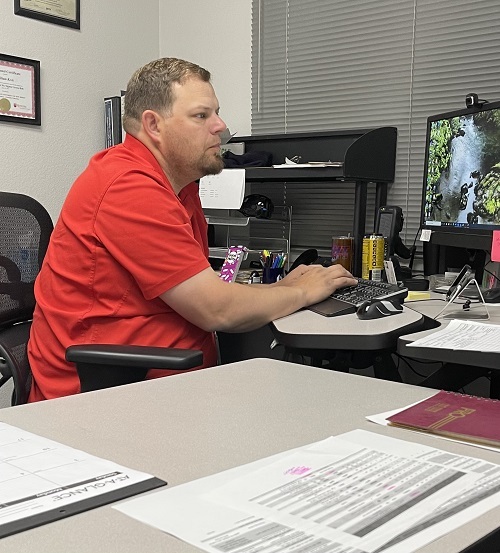 Chuck Roesch, left, and Marty Regan, employees with EM West Valley Demonstration Project cleanup contractor CH2M HILL BWXT West Valley, conduct focused sampling as part of a closure plan for a former waste storage area site.
WEST VALLEY, N.Y. – EM and its cleanup contractor at the West Valley Demonstration Project (WVDP) are working to close a former storage area for hazardous mixed waste, thereby reducing the site’s Cold War footprint and helping protect the environment.
A team of employees from CH2M HILL BWXT West Valley (CHBWV) and a subcontracted driller recently finished soil sampling at the former waste storage site. The sampling is required by a closure plan in accordance with the Resource Conservation and Recovery Act, a public law that creates the framework for the proper management of hazardous and nonhazardous solid waste.
The team is awaiting laboratory results from the samples to determine whether the former waste storage site can be closed.
 A team at EM’s West Valley Demonstration Project worked efficiently to complete sampling of a former waste storage area site in half the time planned. Pictured from left are K.T. Simmons, J.J. Nosal, Marty Regan, Chuck Roesch, Dave Baldwin, Terry Sullivan, Mike Weyand, and Vince Sabin. Team members not pictured include Hugh Foster, Doug Ruszczyk, Paul Fintak, Mike Pendl and Dave Klenk.
The crew completed the sampling in half the time scheduled after working with regulators to develop and implement a plan to evaluate Methyl ethyl ketone, a common laboratory contaminant that had been detected in two locations at the former waste storage site following initial sampling.
That plan included sampling at designated depths for the liquid substance to determine its extent. Methyl ethyl ketone is used as a solvent and to make plastics, textiles and paints.
“The team was able to complete all 21 sample locations within one day,” said David Klenk, CHBWV regulatory strategy environmental compliance and monitoring manager, referring to the second round of sampling. “Everyone was well versed and prepared for their respective job functions, which allowed the whole project to operate safely, effectively and efficiently.”
-Contributor: Joseph Pillittere
AIKEN, S.C. – EM is improving operational reliability through critical infrastructure replacement at a Savannah River Site (SRS) tank farm.
Crews in the site’s H Tank Farm installed a new, 38-foot pipe bridge to transport utility services to the 2H Evaporator. The increased reliability of utility supply will help ensure the evaporator, one of two located in the tank farm, can run efficiently until the end of the liquid waste mission at SRS.
The bridge installation is part of an ongoing project to install new aboveground infrastructure to replace aging underground utilities that service tanks and facilities located on the H Tank Farm’s East Hill. Replacing the utility infrastructure improves the reliability of critical utilities, such as steam, air and water.
There are 43 remaining operational tanks that store radioactive salt and sludge waste at SRS. Savannah River Mission Completion (SRMC), EM’s SRS liquid waste contractor, manages all SRS liquid waste systems, including the tank farms. SRMC is completing the East Hill utilities project for EM.
Improving critical infrastructure will allow the tank farm to better support salt batches for the Salt Waste Processing Facility and sludge batches for the Defense Waste Processing Facility, according to Jim Folk, DOE-Savannah River assistant manager for waste disposition.
“The East Hill utilities project mitigates excavation to repair underground utilities, avoiding potential system downtime,” Folk said. “It is also more cost effective to run new utilities above ground than to replace underground utilities in potentially contamination areas.”
 |
|
Crews install a new pipe bridge in the Savannah River Site’s H Tank Farm that will transport utility services to 2H Evaporator, pictured, which reduces the volume of liquid radioactive waste in the site's 43 remaining operational tanks. |
SRMC President and Program Manager Dave Olson said reliability is one of SRMC’s core values, and the East Hill utilities project is reliability in action.
“Installing permanent, reliable infrastructure is necessary to achieve our long-term mission,” Olson said. “We are ensuring all our systems are reliable so that this team can remain committed to finishing the liquid waste mission by 2037.”
Crews have installed nearly half of the new commodities to support utilities for the East Hill tanks, including anchors, pipes, pipe supports and pipe bridges. The project is set to complete in fall 2024.
-Contributor: Colleen Hart
 Hanford Mission Integration Solutions Storekeeper Cooper Whitney counts items in a Hanford Site warehouse as part of the 100% wall-to-wall inventory process.
RICHLAND, Wash. – A wall-to-wall count that will cover every item located in warehouses and storage areas on the Hanford Site is underway. This process ensures accountability for the accuracy and cost of purchases made on behalf of the EM Richland Operations Office (RL).
The inventory process covers all items within the warehouse network managed by Hanford Mission Integration Solutions (HMIS), the site’s essential-services contractor. The HMIS warehousing and property management team accounts for all items, such as spare parts and materials for future projects, as well as general supplies, waste-packaging drums, respiratory hoods and filters, and numerous other items to support the cleanup mission.
“Accountability to taxpayers includes fiscal responsibility and oversight of all inventories at the Hanford Site,” said James Gagnon, RL industrial property management specialist. “This includes maintaining an accurate tally across a network of more than 15,000 item locations covering 18 different groups of inventory, plus physical buildings and outdoor storage areas.”
 |
|
Hanford Mission Integration Solutions Inventory Specialist William Keck leads this year’s count of all inventories on the Hanford Site. |
The detailed process takes several months, with different items selected each week for counting. If the numbers don’t match, the history of the item is reviewed, and a recount called for. The 2021 inventory covered 470,420 items and resulted in an accuracy of more than 99% for both items and cost.
“Our team prides itself on the tremendous effort made to maintain a highly accurate inventory for the Hanford Site,” said HMIS Property Manager Billy Shoemake. “The team also serves as the steward of property purchased to support cleanup operations.”
HMIS expects to complete the inventory process by the end of September, in time for the end of the fiscal budget year.
-Contributor: Robin Wojtanik
|



